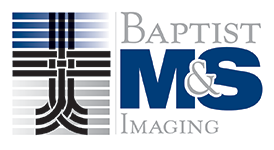Breast cancer is the most common cancer in American women, except for skin cancers. Currently, the average risk of a woman in the United States developing breast cancer sometime in her life is about 12%. This means there is a 1 in 8 chance she will develop
breast cancer. This also means there is a 7 in 8 chance she will never have the disease.
Mammography (a specialized X-ray of the breasts) is the most important tool for screening for and diagnosing breast cancer. The American College of Radiology
(ACR), the Society of Breast Imaging (SBI), the National Comprehensive Cancer Network (NCCN) and other expert medical guidelines recommend beginning screening mammography at the age of 40 and continuing annually, with no upper age limit. The radiologists
at Baptist M&S Imaging strongly agree with these guidelines.
“2D” vs. “3D” Mammography
At Baptist M&S Imaging, all of our breast imaging centers have state-of-the-art mammography equipment. Standard “2D” full-field digital mammography (FFDM) is available at all of our breast centers. The radiologist interprets your mammogram
based on 2-dimensional X-ray images of each breast, as seen from side to side (MLO view) and from top to bottom (CC view). Standard “2D” digital mammograms provide excellent visualization of the breast tissues and are an appropriate modality
for all patients. Three of our breast centers (North Central, Schertz, and Westover Hills locations) also have “3D” Digital Breast Tomosynthesis capability. “3D” breast tomosynthesis takes multiple additional images of each
breast which allows the radiologist to visualize the breast tissue in “thin-slice” images, providing a 3-dimensional effect. “3D” breast tomosynthesis has been shown to increase the accuracy of breast cancer detection, particularly
in women under age 50 or women with dense breast tissue. Discuss with your referring doctor which modality is best for you.
Screening Mammogram
This is a screening exam for a woman who is not currently experiencing any breast symptoms. The exam is done by a registered female mammography technologist who will ensure that your mammogram is performed as comfortably as possible. “2D”
or “3D” technique can be used. The procedure takes about 5-10 minutes, and the typical time spent in our breast center for the appointment is about 30 minutes. One of our breast radiologists will interpret your exam, usually within 1-3
working days. Your referring doctor will typically receive the mammography report within 3-5 working days. You will also personally receive a mammography results letter in the mail within 30 days.
Approximately 10% of women who have had
a screening mammogram will be recalled to have a diagnostic mammogram and/or breast ultrasound. This does not necessarily mean that the radiologist believes that a cancer is present, but does mean the radiologist sees an area in one or both breasts
that requires a more focused imaging assessment.
Not all breast cancers are detected by mammography. For that reason, we also strongly recommend that you have an annual clinical breast exam by your doctor and perform monthly self-breast
exams.
Diagnostic Mammogram
This exam is performed for women who have been recalled after an inconclusive finding has been detected on screening mammogram or if referred by their doctor for a specific breast symptom, such as a newly palpable breast lump. Male patients with breast
symptoms are also appropriate candidates for diagnostic mammogram. Each diagnostic mammogram is tailored to the specific clinical situation of each patient, and the radiologist supervises the process. Breast ultrasound is also often used in conjunction
with, or instead of, diagnostic mammography. Ultrasound uses high frequency soundwaves, rather than X-rays, to create an image of the breast tissue. Anticipate a slightly longer stay in our breast center for a diagnostic mammogram or ultrasound (1-2
hours) since this is an individually tailored exam which is completely reviewed and interpreted by the radiologist prior to your departure. The majority of inconclusive findings detected on screening mammography or clinical breast examination can
be resolved with diagnostic mammography and/or breast ultrasound. If a breast lesion cannot be conclusively confirmed as a benign finding (e.g. a breast cyst) by diagnostic mammogram and/or ultrasound, then the radiologist will usually recommend an
imaging guided needle biopsy, so that a definitive tissue diagnosis can then be made by a pathologist.
Computer-Aided Detection
Baptist M&S Imaging also utilizes Computer Aided-Detection in the interpretation of every mammogram. Computer-aided detection (CAD) works with digitized imaging and computer software to search for unusual breast tissue including calcification, atypical
areas of density or mass. The radiologist reviews the areas marked by CAD on each mammogram to determine if the tissue is normal or requires additional workup with a diagnostic mammogram.
Your Appointment
.jpg?sfvrsn=184535f_0) To help your doctor determine the best mammogram test for you, talk with him/her about your personal and family history of breast cancer, any changes or problems with your breasts, surgeries,
and hormone use.
To help your doctor determine the best mammogram test for you, talk with him/her about your personal and family history of breast cancer, any changes or problems with your breasts, surgeries,
and hormone use.
Speak with your doctor if you are pregnant or think you could be pregnant. The best time to schedule your mammogram is about 1 week after your period.
On the day of your appointment:
- Do not wear deodorant,
lotion or talcum powder under your arms, on your arms, or on your breasts.
- Advise the technician of any breast symptoms or problems prior to starting the exam and accurately complete the breast questionnaire. (Of note, screening mammography is
specifically for women with no new or concerning breast symptoms. If you have a breast symptom, such as a new breast lump that you can feel, please inform your referring doctor so that a diagnostic mammogram can be ordered rather than a screening
mammogram.
- Ask the technician when you can expect the results of your mammogram. Keep track of the results date and follow-up with your doctor if you have not heard from them by that date.
- Notify the mammography staff of any mammograms you
have had at other facilities. It is ideal if you provide us with this information several weeks before your scheduled mammogram. With your permission, our staff will request your prior mammograms from the other facility, even if out of state.
Your prior mammograms will assist the radiologist in making an accurate interpretation of your current mammogram in a timely fashion.
Click here for Exam Prep



.jpg?sfvrsn=184535f_0) To help your doctor determine the best mammogram test for you, talk with him/her about your personal and family history of breast cancer, any changes or problems with your breasts, surgeries,
and hormone use.
To help your doctor determine the best mammogram test for you, talk with him/her about your personal and family history of breast cancer, any changes or problems with your breasts, surgeries,
and hormone use.